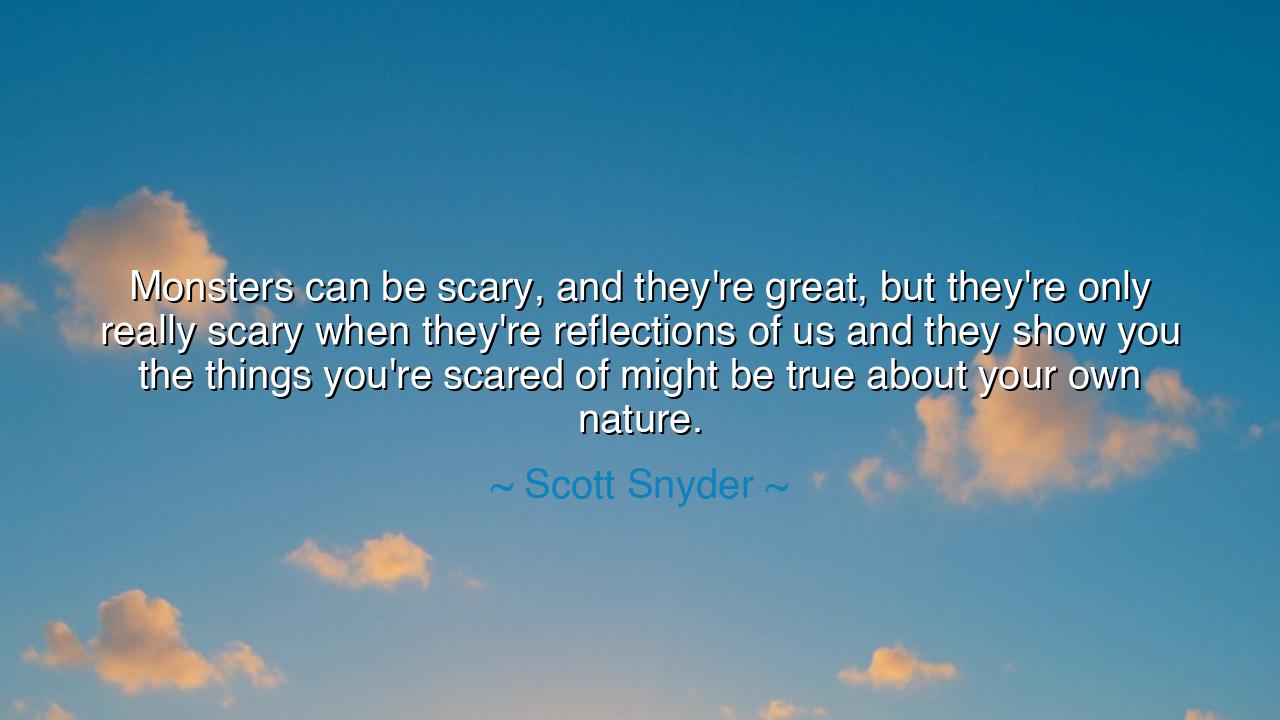
Monsters can be scary, and they're great, but they're only
Monsters can be scary, and they're great, but they're only really scary when they're reflections of us and they show you the things you're scared of might be true about your own nature.






Scott Snyder, teller of dark tales, spoke with piercing clarity when he declared: “Monsters can be scary, and they're great, but they're only really scary when they're reflections of us and they show you the things you're scared of might be true about your own nature.” In this insight lies the ancient recognition that the most terrifying creatures are not those that come from the outside, but those that mirror the shadows within us. A beast of fangs and claws may startle, but a monster that exposes our own hidden corruption strikes fear that lingers in the soul.
The meaning of this truth is that monsters in story and myth serve as mirrors. They are not merely horrors invented to thrill, but symbols of the dark potential of the human spirit. When we tremble at the vampire’s hunger, we are seeing our own greed and lust. When we shudder at the zombie’s endless consumption, we are seeing our own capacity for mindless destruction. When we recoil from the werewolf, we are seeing the beast that lives within us, waiting for fury or desire to unchain it. It is this reflection that truly terrifies, for it whispers that the horror we fear outside may already dwell within.
The origin of such understanding lies in the myths of old. The Greeks told of the Minotaur, half-man and half-beast, born from human folly and hidden in a labyrinth — a reflection of the darkness mankind tries to bury but cannot escape. In the Book of Genesis, the serpent tempts humanity by awakening desire, showing that the true danger lies not in the snake’s fangs, but in the weakness of the human heart. From age to age, storytellers have known that monsters endure not because they are alien, but because they are intimate — they speak to what we fear we might become.
History gives us stark reminders of this truth. The horrors of the Holocaust or the atrocities of war were not committed by beasts, but by human beings, ordinary men and women who allowed hatred, fear, and blind obedience to unleash monstrous acts. The world saw then that the true monster is not always an alien figure, but the human heart twisted by ideology and cruelty. Similarly, writers like Mary Shelley in Frankenstein showed us that the creature we call a monster was created by human pride and neglect, a reflection of our arrogance in seeking power without responsibility.
Snyder’s words also warn us about self-recognition. It is easy to point at monsters in stories and call them evil, but harder to look into the mirror they hold up and admit that their flaws resemble our own. That is why true horror unsettles us: not because it is strange, but because it is familiar. To confront the monster is to confront our own potential for anger, cruelty, selfishness, or apathy. It forces us to admit that the line between human and monster is thin, and easily crossed.
The lesson for future generations is clear: beware not only of external dangers, but of the seeds of monstrosity within yourself. Do not assume that evil always wears a mask or comes from outside your tribe, your nation, or your heart. Understand that every human carries within them the potential for cruelty as well as compassion, destruction as well as creation. The true battle against monsters begins with vigilance over the self.
Practical action flows from this wisdom. Reflect often on your own fears and impulses, for they may reveal where your shadow lies. Do not deny your flaws, but confront and master them, lest they master you. When you see monstrosity in others, ask yourself if its roots can also be found in your own heart, and work to uproot them. And through art, story, and reflection, learn from the monsters — not to imitate them, but to recognize and overcome the truths they reveal.
Thus, Snyder’s words endure as a teaching cloaked in shadow: monsters are most terrifying when they are us. They are not only beasts of nightmare but mirrors of our hidden truths. To face them is to face ourselves, to accept the darkness we fear, and to strive to rise above it. For the true measure of humanity is not in denying the monster within, but in mastering it, and choosing again and again to walk the path of light.






AAdministratorAdministrator
Welcome, honored guests. Please leave a comment, we will respond soon